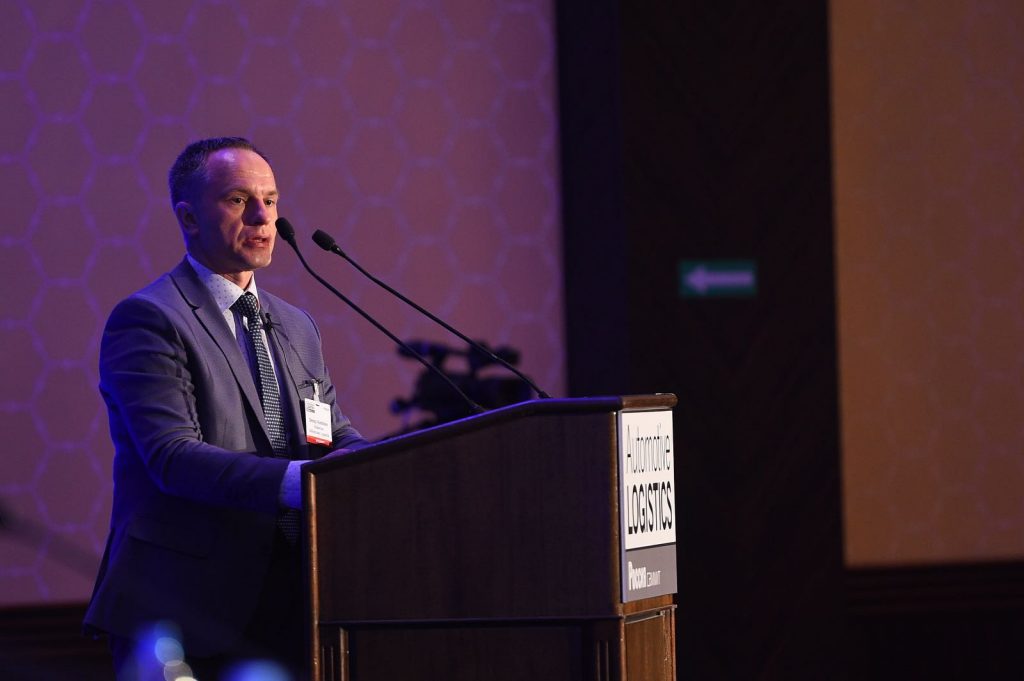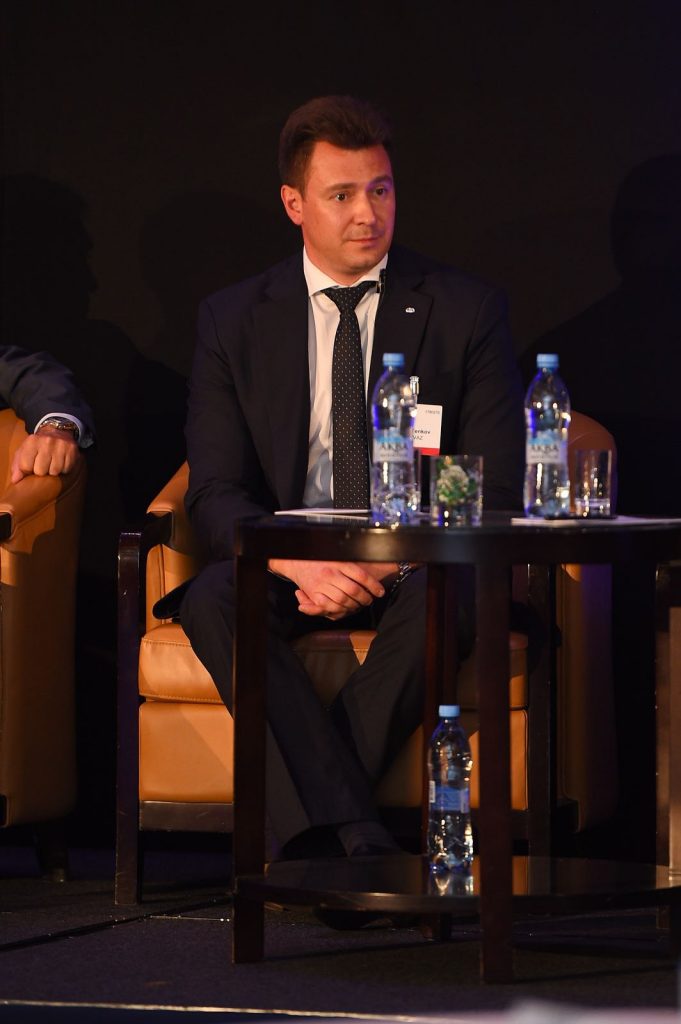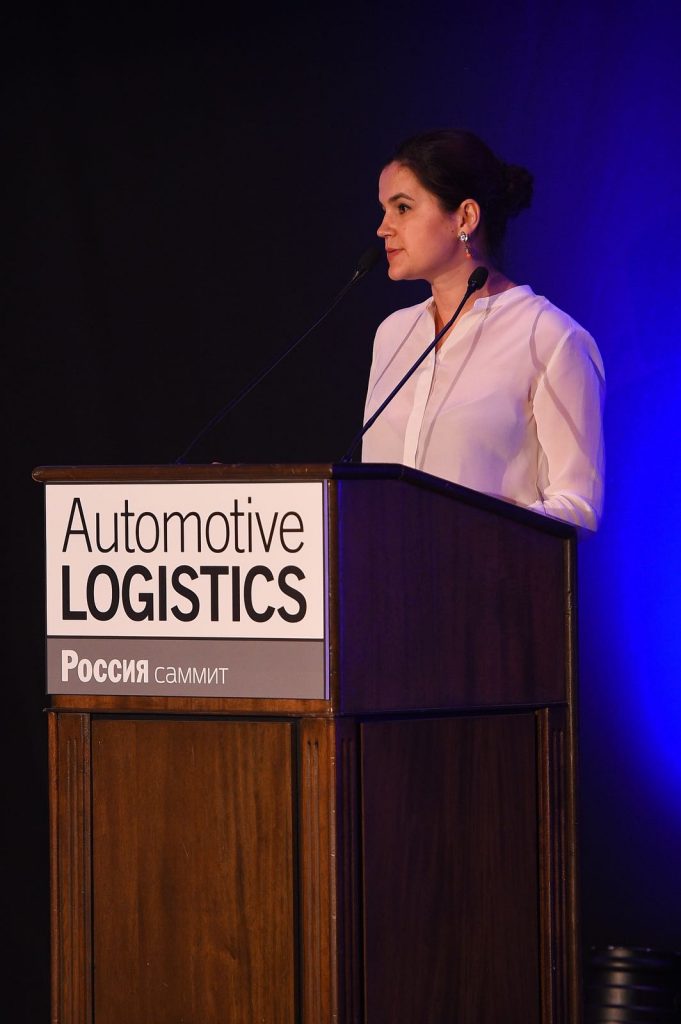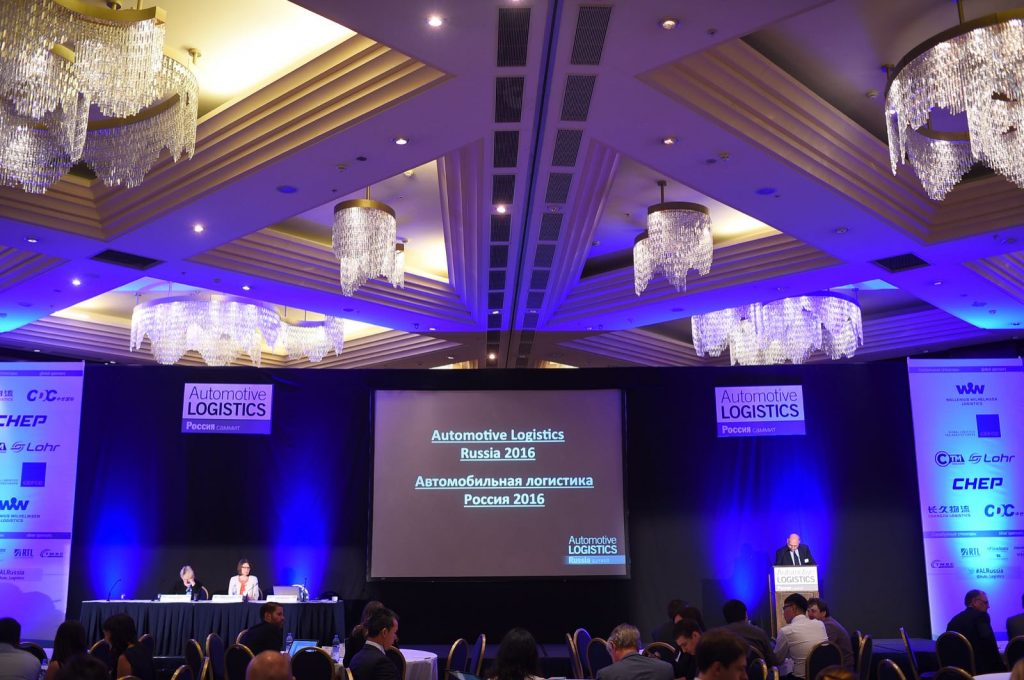Russia conference: Light at the end of a long tunnel
We've seen a lot of changes at the Automotive Logistics Russia conferences over the years. Currently, it's less a case of 'winter is coming', more 'winter is here'. However, despite the bleak outlook, if automotive companies can weather the storm, the country is eventually expected to recover, write Christopher Ludwig and Rachael Hogg
[sta_anchor id="1"]Russia’s long winter continues for the country’s economy and automotive industry, chilled in the deep freeze of its fourth consecutive year of steep falls in new vehicle sales and production. Russia has faced something of a “perfect storm”, in the words of one analyst, with the fall in energy prices hitting the petrol state hard, a rouble that has depreciated sharply against most major currencies, economic sanctions with Europe, the US and Japan, as well as poor economies and relations across what would otherwise be Russia’s key trading partners across the Commonwealth of Independent States (CIS), including Ukraine and Kazakhstan.
In this story...
“Right now there is the ‘perfect storm’, which means that practically everything that could happen in one country, has happened,” said Tatiana Hristova, manager of central and east European light vehicle sales forecast at IHS Automotive. “Along with falling energy prices and economic sanctions, there have also been significant geo-political factors that couldn’t be predicted, whether the crises with Crimea, Ukraine, Turkey and recently with Egypt [where a Russian passenger plane was brought down in a terrorist attack].”
The result has been a prolonged decline in Russian vehicle sales, from a peak of around 3m light vehicles in 2012 to nearly half that level last year, with sales around 1.6m units. Hristova expects sales to fall to 1.4m this year (below the 2009 low following the financial crisis). Russian vehicle production, meanwhile, will fall to as low as 1.2m units this year, a drop from 1.3m in 2015 and 2.1m in 2012.
For automotive logistics, the impact has been harsh, both indirectly as a result of Russia’s struggling economy, as well as directly, where sanctions or wider trade disputes have hit automotive freight. After Turkey’s military shot down a Russian fighter jet that had crossed into its air space last autumn, for example, the Russian government imposed import bans and extra security measures on products from Turkey. For several months that made it difficult or even impossible to move vehicles or parts from Russia to Turkey – a particular problem for Ford Sollers, which imports components and spare parts from Turkey, including for production of the Transit at the joint venture carmaker’s plant in Elabuga, Tartarstan.
According to Sergey Bannov, director of material planning and logistics at Ford Sollers, the company was initially in “a bit of a pickle” when it came to moving parts and finished vehicles. However, products that were submitted with the right documents and following extra security measures – such as submitting X-ray scans of containers – have helped trade to flow again.
Also from Moscow...
- The long road to recovery
- Turkish exports still struggling to find their way into Russia
- Why forecasts are futile in the finished vehicle sector
- Quality is more important than ever for Toyota
- Russian car exports to Ukraine pick up
Likewise, Russia has also seen its trade with Kazakhstan suffer this year after the latter country started levying ‘utilisation fees’ on vehicles imported from Russia, a charge that is meant to the cover the cost of recycling vehicles that is usually considered a way of increasing duties (a measure that Russia itself has frequently employed). This charge, together with other duties, has virtually dried up vehicle exports to the country, accounting for a large share in a decline in Russian vehicle exports.
More broadly, the automotive logistics and supply chain sector in Russia is arguably in survival mode. While General Motors’ exit last year from most operations and sales in Russia last year has been one of the few examples so far of OEMs shutting plants in the country, there has been a wider exodus and lack of investment among tier suppliers, something that has made supply localisation and proximity in the supply base much more difficult.

Sergey Bannov, director of material planning and logistics at Ford Sollers
Several logistics providers have also gone out of business or left the market, as the value of automotive logistics services has declined, and transport rates have hovered at low levels. Alexey Tenkov, director of logistics at Avtovaz, Russia’s largest carmaker, which builds the Lada brand, admitted that the tariff structure between carmakers and logistics providers has gotten “terribly complicated” and needed reform from both sides.
“We have to work together to make sure that don’t end up forcing companies to shut their doors. More logistics providers are falling out of the market,” he said.
For finished vehicle logistics, the market has declined in parallel to the market. Elena Lukanova, president of Poland-based carrier Adampol, whose Russian brand Vectura operates a large car transporter fleet and several terminals, revealed figures that suggest the total transport value of vehicle logistics by road in Russia has declined from 20.3 billion roubles ($31.8m) in 2014 to around 10.6 billion this year. She also estimated the number of active transporters has fallen during the same period from 2,400 to 1,333.
“The industry is losing quality drivers and managers,” she said.
Anastasia Tsurkan, manager for outbound logistics at Hyundai Glovis Rus, the logistics arm of the Hyundai Motor Group, also pointed to structural problems in the Russian logistics network that were causing further problems for logistics providers. Notably, there is a severe imbalance of flows coming from the east, mainly from the Volga region where Avtovaz builds vehicles (together with alliance partners Renault and Nissan), compared to vehicles coming from factories or imports in western Russia, which represents the primary consumption market.
“There is chaotic load carrying. Logistics providers pay a lot of fines and spend a lot of time idling, which also leads to poor truck efficiency and pickup performance,” she said.
“The risk is that more carriers will leave the market and we will have a shortage, especially when the market starts to recover.”
[sta_anchor id="2"]The deep freeze set to thaw?To many at this year’s Automotive Logistics Russia conference in Moscow, the prospect of problems associated with growth and recovery might feel like something of a dream from another time. Currently, sales and production are still falling, with exports also in decline; according to IHS forecasts, light vehicle exports from Russia this year will decline from 115,000 in 2015 to around 80,000 this year.
 Tatiana Hristova, manager of central and east European light vehicle sales forecast at IHS Automotive
Tatiana Hristova, manager of central and east European light vehicle sales forecast at IHS AutomotiveHowever, several forecasts at the conference suggested that 2016 would be the bottom of the market, with growth expected to resume in the second half of 2017. “Consumer expectations will stabilise, and the population of Russia will adapt to the new conditions and prices and currency exchange rates. As a result, we will start consuming more on the whole, and on the other side, the exchange of vehicles in the second half of 2017 will support sales in the Russian automotive market,” said Hristova.
However, she does not currently expect a ‘V’ shaped recovery, such as what Russia saw following the huge drop in 2009. Instead, she predicted a slow forming ‘U’. While Hristova said that sales of 3m units again are “easily achievable” in Russia, IHS does not currently see those levels returning until 2026 or 2027. Local production, meanwhile, which has gained substantial market share over the import of vehicles since the last market peak, will also rise slowly over this period, expected to reach 2.7m by 2026.
It is quite a far cry from forecasts earlier in the decade which expected Russia to surpass Germany as Europe’s largest market by as early as last year, and which had projected the country to approach 4m units by 2020.
Nevertheless, Hristova’s outlook would suggest a sustained period of reasonable growth in Russia, which would require planning and even investment now. Adampol’s Elena Lukanova also pointed to forecasts that suggested a return to modest growth next year, with sales rising from 1.38m units this year to 1.5m in 2017 and 1.72m by 2019. With that increase, she expected the car transport market to recover at a faster pace, rising from 10.6 billion roubles in 2016 to 15.4 billion roubles by 2019. The car transporter fleet should increase from 1,330 to 1,660 trucks.
She called for carmakers and logistics providers to work together in long-term contracts to help ensure stable rates, investment in equipment and the right emphasis on quality. As an example, she pointed to Vectura’s recent contract with Ford Sollers, which was signed last years for five years, covering distribution and the development of compound storage services in Tartarstan. As part of the agreement, Vectura will invest in 100 new trucks over the coming years to support the business.
 Elena Lukanova, president of Poland-based carrier Adampol
Elena Lukanova, president of Poland-based carrier AdampolLukanova suggested that now would be a good time for other companies to also consider their fleet and operations. “We believe that now is a good time to start investing to make sure that the market has the capacity and the drivers to handle growth at the right quality,” she said.
Not everyone necessarily agreed that now was the right time to restart investments, or even to lock in long-term contracts. Konstantin Skovoroda, chief executive officer of Russian Transport Lines, reported that during roundtable discussions at the conference that several carriers didn’t want to risk locking in freight rates at such low levels. Some providers are simply still more focused on surviving.
“Some participants don’t think that contract terms are a panacea. Others also feel that now is not the time for a big investment, and OEMs are under no illusion that fleets will be renewed immediately,” he said. “The issue will balance itself out.”
[sta_anchor id="3"]Exporting out of the holeAnother area where Russia’s automotive industry may also return to growth is in vehicle exports. Some carmakers are looking to take advantage of the rouble’s sharp decline to increase exports, and so far there have already been announcements by the likes of Hyundai about intentions to direct further exports to Egypt, for example. Others, such as Avtovaz, have ambitious export targets to a range of markets across CIS countries, eastern Europe and even Asia.
Standing in the way, however, is Russia’s relatively poor reputation for quality, brands and competitiveness, as well as a poorly developed logistics and distribution network globally. Finally, Russian factories are not all geared for global exports and would struggle to compete against the available capacity in other markets, whether in Europe, Asia or North America.
While Russia’s light vehicle exports are currently falling (and are expected to account for just 0.71% of European exports this year), Hristova from IHS anticipates relatively strong growth over the next decade or more. In an IHS base scenario, she said light vehicle exports could reach 340,000 a year by 2029, including 170,000 units going to eastern Europe, 5,000 to the Middle East and Africa, 4,000 to South America, with no real opportunities for North America or South Asia. In the short-term, there could be some exports to Vietnam and South Asia, but those regions are looking to build their own production sites.
In a more optimistic scenario, Hristova said that exports could reach 635,000 by 2029, including the potential for some export to Asia and fairly significant volume to South America.
The Russian government is also offering help. It recently announced it would provide a budget of 3.3 billion roubles (around $50m), to support the export of cars from assembly plants in the country, according to Dmitri Vostrikov, managing director of Russia for WWL. The subsidy will help with a variety of logistics expenses, including offering up to 100% to bring cars in line with international standards, up to 80% to cover inland transport costs to the Russian border, and up to 50% for sea transport.
The government will also reimburse companies for inland transportation up to 5.6 roubles per kilometre for passenger cars, up to 11.2 roubles per kilometre for SUVs, up to 24 roubles per kilometre for commercial vehicles, up to 56 roubles per kilometre for buses and trucks, and up to 24 roubles per kilometre for self-driving transport.
It is unclear whether these subsidies will have a substantial impact on increasing Russian exports, and whether carmakers would use Russian plants over existing capacity in other markets. There are also other blocks that could stand in the way of Russia increasing its exports. The popularity of Russian brands is not high, and consumers have high expectations regarding quality issues. Russia's logistics network is also underdeveloped, and there is extremely high competition on European markets.
However, Russia has a widespread locally assembled product portfolio, high assembly quality, advantages from currency depreciation, and government support. The current economic situation also means that Russian manufacturing will have a competitive advantage over the next five years, with the savings per car standing at around €250 ($277) per vehicle.
 Dmitri Vostrikov, managing director of Russia for WWL
Dmitri Vostrikov, managing director of Russia for WWLWhile the idea of increasing exports is appealing, Russia will also face high trade barriers. The average import tariff to South America is around 35%, as is Africa. The Middle East is around 5%, but Iran can be up to 90%, and South Asia more than 100%, making exports extremely unlikely.
There is also the question of sanctions. It is forecast that Russia's geopolitical situation will start to improve from the second half of 2017 when sanctions are slowly abolished, at least from the EU. Hristova said that it is likely that European sanctions will begin to be lifted in 2018, although American sanctions could be prolonged for more years. “But we don't see significant potential for exports to the US in any case,” she said.
At Avtovaz, Tenkov admitted that exports offered considerable opportunities, and that the company has important ambitions, including for vehicles built on a new product line. However, he admitted that developing effective logistics to handle these exports would be a challenge.
“We need to develop the right logistics. We already have several projects in the pipeline, and it will require a lot of work both inside and outside of Avtovaz,” he said. “We have a lot to do to get there, including increase local content and other improvements. But exports is probably one of the best and most promising areas for us.”
Sergey Bannov at Ford Sollers suggested that exports could be a possibility for his carmaker and others, especially since the joint venture is building global products. He suggested that politics would likely determine the potential for Russian exports. “Whether it will happen quickly or at all depends on politics, including decisions on tariffs and regulation.”
[sta_anchor id="4"]Going localSupply localisation also remains a major target and topic across the Russian automotive industry, both for carmakers and for the government. As this publication has long reported, supply localisation remains relatively low in Russia. Carmakers have signed various agreements with the government to meet different targets in exchange for exemptions on import tariffs. However, with the decline in the Russian market, some of those targets are harder to achieve for some carmakers.
 Alexey Tenkov, director of logistics at Avtovaz, Russia’s largest carmaker
Alexey Tenkov, director of logistics at Avtovaz, Russia’s largest carmakerAlong with the industrial agreements with carmakers, the Russian government has also set up of import replacement programmes that aim to reduce manufacturers’ dependency on foreign components, according to Ksenia Sizova, association at DLP Piper, a law firm specialising in Russian customs and policy.
Automotive components figure into some of these policies. For example, the Ministry of Industry and Trade has set a decree that suggests that by 2020, gearboxes in Russia should have a localisation rate of 70-80%. Today, however, virtually 100% of gearboxes used in the industry are imported, and it is not clear how manufacturers are going to reach this level over the next four years.
It is possible, however, to obtain deferrals from the government in the event that companies can prove that no alternatives exist in Russia, says Sizova. At the same time, there are also special investment contracts that manufacturers can gain that offer support in increasing in localisation, in which a number of automotive companies have applied, including Mazda, Hyundai and Daimler.
Sizova also pointed out that government support tends to be more robust for carmakers than for tier suppliers, with many programmes aimed at OEM’s research and development or local adaption, but few equivalents for suppliers. “There have been quite a lot of measures for OEMs, including subsidies for R&D, to help meet Euro 5 engine standards, or for covering loan interest rates,” she said. “But for tier suppliers, there have been fewer measures. We hear a lot concern about this.”
However, she also noted that the government is open to dialogue and can be flexible. For example, although a number of companies seem likely to have missed the 2015 localisation target, the government is expected to confirm an extension very soon.
Tatiana Hristova also suggested that the government had shown a willingness to listen and understand the sector. “We find that the ministries are ready to initiate dialogues with manufacturers. If you get to them with your issues, you are likely to get what you are asking for,” she said. “One example of this is the support for logistics costs for exports. It shows that they are willing to do things.”
[sta_anchor id="5"]Focus on efficiencyFor logistics executives at carmakers, the biggest focus was on improving efficiency and keeping costs lower. For Alexey Tenkov at Avtovaz, this shouldn’t just be about reducing freight rates further or squeezing providers, but for finding routing, consolidation and other network improvements.
“
 Ksenia Sizova, association at DLP Piper, a law firm specialising in Russian customs and policy
Ksenia Sizova, association at DLP Piper, a law firm specialising in Russian customs and policyWe cannot think only about tariffs, but we have to think about engineering and how to change processes,” he said. “For Avtovaz, our volumes are big but efficiency has to be improved. Transport has to be good and reliable with qualified drivers and personnel.
“You cannot just do all of this during a crisis but has to be prepared in advance and over the long term,” he added.
For inbound logistics, which Tenkov is focused on since rejoining the company earlier this spring (he’d previously worked at GM and also at Avtovaz before that), he pointed to the potential for improving packaging in particular, including keeping track of returnable containers and improving turnaround times for equipment.
Sergey Bannov at Ford Sollers also stressed the importance of a continuing focus on improving costs and quality. He challenged delegates to be open to change and not just to work based on received ideas. He pointed to a logistics flow for Ford from Canada that had been going via the US before shipment to Europe. It had seemed strange and wasteful, so the company started shipping it direct. However, it turned out to be more efficient to consolidate material first in Chicago, and so the material continues to move southbound before being shipped to Europe.
He also pointed to other areas of the supply chain, including packaging. “We focus a lot on using more durable, returnable packaging, but in some cases it works better to use expendable packaging,” he said. “We have to simplify what we do wherever possible.”
 Alexey Kokotkin, manager of vehicle logistics at Toyota Motor Russia
Alexey Kokotkin, manager of vehicle logistics at Toyota Motor RussiaFor other carmakers, the crisis has not deterred them from focusing on quality and performance in their logistics operations. Alexey Kokotkin, manager of vehicle logistics at Toyota Motor Russia, suggested that now was a good time to “make practical steps with LSPs to improve quality”. He revealed that Toyota’s damage rates for vehicle logistics were now at 0.37% for road and 0.31% for rail. While there have been a rise in the incidents of major issues, overall the trend toward lower damages continues.
Kokotkin credited this improvement to careful investigation of root causes of damage carried out together with logistics providers. For example, Toyota was able to discover that oil damage on some vehicles was the result of a cheap tube that carriers were using on car carrier equipment; investment in a better product reduced such incidents.
The carmaker has also focused on improving training and incentive schemes for drivers. Toyota now aims to hold at least two training sessions each year with drivers with the intention of addressing a range of processes to improve loading and handling. “We also think it is important to motivate drivers both in a financial sense and non-financial,” he said. “It is important to send positive messages about their social standing and, where possible, to offer financial rewards.”
Toyota’s focus with logistics providers, as well as the Ford Sollers contract with Adampol/Vectura, highlighted the important role that logistics providers continue to play for carmakers and tier suppliers in Russia, including the potential, where possible, to manage more value added and strategic services and encourage cross-party collaboration. Elena Lukanova called on manufacturers and logistics providers to work more closely together to understand the needs across OEMs, car carriers and 4PLs, for example.
 Anastasia Tsurkan, manager for outbound logistics at Hyundai Glovis Rus
Anastasia Tsurkan, manager for outbound logistics at Hyundai Glovis RusAnastasia Tsurkan from Hyundai Glovis, which owns a majority stake in Adampol, also called on closer collaboration across providers and OEMs in an effort to deal better with inconsistent flows, poor forecasting and a lack of standards. “We need to cooperate among OEMs to help improve truck utilisation and return loads, develop more predictable planning and achieve higher levels of harmonisation,” she said.
At Ford Sollers, Sergey Bannov also said that the carmaker was open to further integration and outsourcing with logistics providers, although that each decision would be made on a case-by-case basis. For example, Ford Sollers recently signed a direct contract with an ocean carrier for container shipping, eliminating third party providers between the OEM and the vessel owners. The carmaker has also insourced a number of plant and warehouse operations at its plant in St Petersburg, even as it has chosen to outsource more outbound services in Tartarstan.
“We are ready to elect any solution that proves to be more effective than the other.
At Avtovaz, which has traditionally run a large inhouse operation across its supply chain, including owning its own fleet of trucks for in-plant logistics in Togliatti and nearby suppliers, Alexey Tenkov maintained that the carmaker remained open to outsourcing opportunities, although in some cases the lack of expertise across Russian providers was an obstacle.
“We are ready to outsource operations, but in many cases logistics companies lack knowledge or expertise,” he said. “If we outsource, it needs to be based on both achieving stability and cost efficiency. Everything depends on planning and processes.”
Automotive Logistics Russia is part of the global Automotive Logistics series of conferences.
The next conference in the series is Finished Vehicle Logistics Import/Export North America in Baltimore, Maryland on August 10th.
The next conference to be held in Europe will be Automotive Logistics UK in London, England on October 5-6th.










